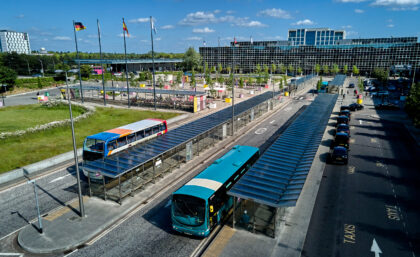NICE Prioritise active travel over vehicles
Physical inactivity is responsible for one in six deaths and is believed to cost the UK £7.4 billion each year, including £900 million to the NHS.
Active travel including pedestrians, cyclists and those who use public transport should be given priority when new roads are built or upgraded, NICE (National Institute for Health and Care Excellence) has said.
NICE says planners should develop policies and initiatives to ensure that safe, convenient, inclusive access for pedestrians, cyclists, and people who use public transport is maximised and is prioritised over motorised transports (cars, motorbikes and mopeds, for example).
The proposal is made in a draft quality standard for encouraging physical activity within the general population – published today (Friday 4 January).
The aim is to get people to be more active in their day-to-day lives by encouraging safe, convenient, active travel that is accessible for everyone, including older people and people with limited mobility.
They should also aim to provide tactile paving and even surfaces for those with limited mobility, and non-reflective, anti-glare paving surfaces for people with visual impairments.
Professor Gillian Leng, deputy chief executive and director of health and social care at NICE, said: “Getting people to be more physically active by increasing the amount they walk or cycle has the potential to benefit both the individual and the health system.
“As a society we are facing a looming Type 2 diabetes crisis, which is in part caused by people not exercising enough. We need more people to change their lifestyle and to take more exercise.
“People can feel less safe when they walk or cycle compared with when they drive. We’ve got to change this.
“So asking planners to prioritise pedestrians, cyclists and those who use public transport when roads are built or upgraded can ensure they are safe, attractive and designed to encourage people to get out from behind their wheel.”
Joe Irvin, CEO of Living Streets, the UK charity for everyday walking, said: “For decades our towns and cities have been built to prioritise motor vehicles; resulting in unhealthy air, congested roads and a decline in people walking everyday journeys.
“The better planning that NICE is suggesting is absolutely necessary. Those who are the most vulnerable – children and older people – are currently suffering the most from bad air, unhealthy lifestyles and social isolation.
“It’s time that towns and cities were built for everyone – first and foremost for those on foot. Placing key services like schools, GP surgeries and bus stops within walking distance is vital. More people getting out and walking everyday journeys, such as to work or school, will make us a healthier country.”
According to NHS Digital in 2016, 26 per cent of adults were classified as obese. This was a 15 per cent increased from 1993 but has remained at a similar level since 2010.
Physical inactivity is responsible for one in six UK deaths (equal to smoking) and is estimated to cost the UK £7.4 billion annually (including £0.9 billion to the NHS alone).
Other statements include:
- Local authorities and healthcare commissioners employing physical activity champion to oversee the development and implementation of local strategies, policies and plans.
- Local authorities involving community and voluntary groups to design and manage public open spaces.
- Workplaces having a physical activity programme to encourage employees to move more and be more physically active.
- Schools and early years settings monitoring and updating their travel plans annually to increase active travel.
A consultation has now begun on the quality statements in the documents and commissioners, service providers, health and public health practitioners and the public have until Friday 1 February to have their say via www.nice.org.uk


